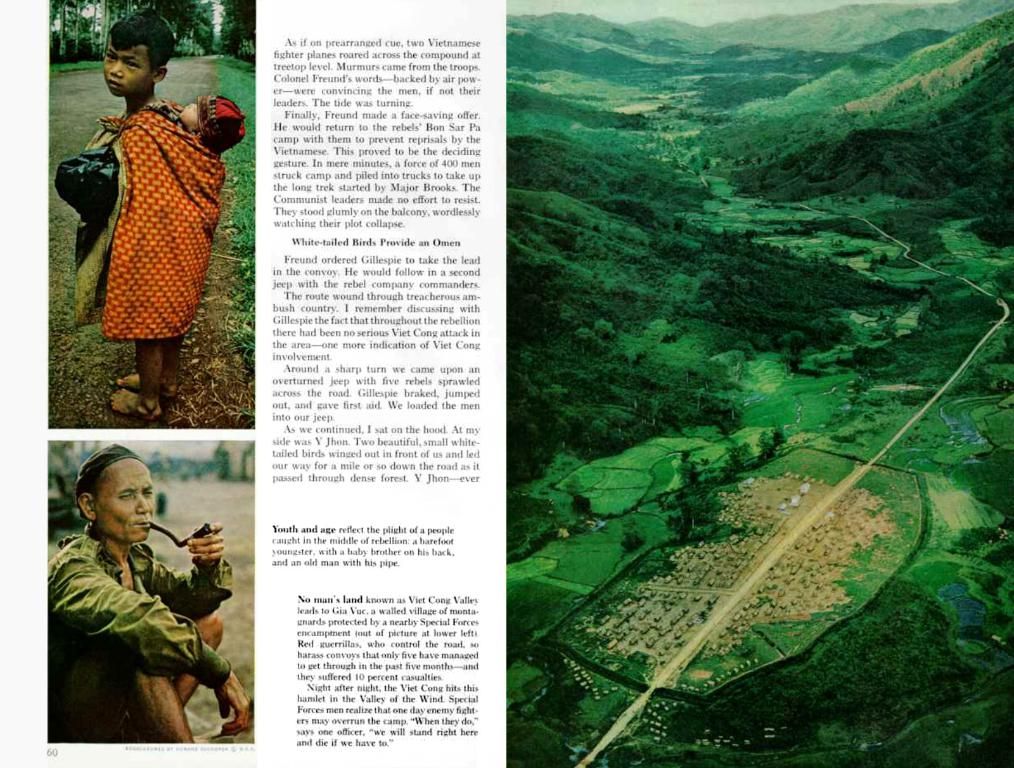Winter Hydration: The Hidden Essential for Your Frosty Frolics
Why Winter Dehydration Can Be Deadly
Surviving Winter in Colorado Rockies' Frozen Wilderness - Installment 5: Maintaining Hydration in Cold Terrain
Winter in the frostbite-filled Colorado Rockies is as picturesque as can be, until dehydration creeps up on ya like an avalanche. Whether you're skiing down the slopes of Breckenridge, snowshoeing through the icy wonderland of Rocky Mountain National Park, or attempting to take that Gram-worthy shot with your mobile while hiking frozen trails, staying hydrated is the lifeblood of your alpine escapades!
In this compass-pointed guide, we'll show you how to wrangle water in the winter whites, whether you're a grizzled bushcrafter or a fresh-faced powder chaser. And hey, if you're the kind who figures your hydration pack can keep you going for days or if you're thinking about eating an icicle to quench your thirst, read on! You'll discover why neither idea is a good one.
Why It's Important to Stay H2O-rich
First things first: winter isn't a vacation for dehydration. In fact, dehydration can hit harder during winter activities since cold air can fool your body into thinking you're less thirsty. Wrestle in the snow, throw 'round some rocks, do the snow angel dance, and you'll be sweating more than you think.
Signs of Winter Dehydration
- A Dry Mouth and Throat: The first signal that you're low on H2O.
- Fatigue: Feeling drained and exhausted? Likely a symptom of dehydration.
- Dizziness and Lightheadedness: Feeling like you might keel over? Low fluid levels could be to blame.
- Dark Urine: If your wee is dark yellow, chances are your dehydration game is strong.
- Irritability: If you find yourself acting like a frostbite victim is a thing with legs, you might want to guzzle some H2O STAT!
Mastering the Art of Water Sourcing
When Mother Nature decides to wrap your favorite mountaineering spot in a frozen shawl, finding H2O sources can be a Herculean task. Rivers and streams may be frozen solid, and snow – while abundant – requires careful handling to make it drinkable.
Melting Snow and Ice
- Snow First, Heat Second: Always melt snow before consuming it. Putting ice into your mouth can cause your core temperature to drop, sucking the heat out of your body and draining precious calories.
- Choose Clean Snow: Go for fresh, white snow, far away from discolored or debris-laden patches. These could be contaminated with germs, chemicals, or other stuff you really don't want in your gullet.
- Melting Tips: Get a stove or portable burner going to melt the snow. Fill your pot halfway, melt it down, and add more snow. This way, you won't scorch your cookware and the melting process goes faster.
- Ice is Better Than Snow: If you've got access to clean ice, use it! It's denser and gives you more drinking water per volume, saving you time and fuel.
Making Your Water Work Wonders: Snow and Ice Are Not Your Clean Counselors
Even if it's frozen, snow and ice can be teeming with bacteria, viruses, or pollutants. Remember, just because it's frozen doesn't automatically make it clean!
Purification Methods to Save the Day
- Portable Water Filters: These handy devices are small and easy to carry, beloved by outdoor enthusiasts. Brands like Sawyer or Katadyn are excellent at removing most bacteria and protozoa. Keep in mind that filters can freeze in cold weather, so after use, store yours close to your body or in an insulated container to keep it from cracking.
- Purification Tablets: When you've got your tent all set up and you're ready for a rest, trusty tablets like Aquatabs or iodine-based treatments are lightweight and effective. Just hang onto them for about 30 minutes to 4 hours, depending on the product, and your H2O will be as pure as a mountain stream.
- Boiling: Boiling is a simple, reliable method for purifying water. Bring it to a rolling boil for at least one minute at lower altitudes. If you're above 10,000 feet, go for three minutes to be safe.
Hydration Hacks in Pictures
Quickly purify your water with these helpful visuals!
- Water purification chart
- How to make pine needle tea for a warming, vitamin-packed beverage
- How to use snow to prevent your water bottle from turning into an ice popsicle overnight
- How to build a water generator to melt snow into drinkable H2O
Avoiding Dehydration in Winter
Here comes your winter hydration survival game plan:
Pre-game Planning
- Pack More H2O Than Needed: Winter conditions often require more hydration due to the added physical effort and dry air. Get a hydration bladder that can hold more water than you think you'll need.
- Insulated Water Bottles: Pack a bottle that can keep your water from freezing. Look for bottles with wide mouths; they're easier to use when the water starts to congeal.
Staying on the Hydration Ball
- Set reminders to drink every 20-30 minutes while you're engaged in winter activities.
- Add flavoring to your H2O. A pinch of electrolyte powder or a splash of lemon juice will liven up your drink and help replenish depleted electrolytes.
Buzzkills to Avoid
- Avoid caffeine and alcohol. They dehydrate you and will leave you feeling hopeless in a survival situation. Sip on herbal teas or warm, non-caffeinated drinks instead.
Pine Needle Pure Delight: A Self-Serve Winter Refreshment
Forgot your tea bags but still want a warm beverage to sip on? No worries! If you happen to be in a pine forest, you've got the perfect ingredient for a soothing, piney pick-me-up. Just remember to avoid Ponderosa Pine – it has been linked to causing premature births in cattle, so it's best to steer clear. Stick to other pine varieties for your tea-making. Blue Spruce, anyone?
Pine needle tea recipe:
- Collect Fresh Needles: Obtain a handful from the youngest tips of the branches. They're milder in flavor and easier on the palate.
- Prep the Needles: Remove the needles from the stem and either chop them up or bruise them a bit. This will help release their oils and nutrients into the water.
- Steep: Add the prepared needles to a cup of hot water. Let them steep for around 5-10 minutes, then strain (if desired).
To the wilderness, my friends! Keep your water bottles hydrated and your heart ablaze. And don't forget: the pursuit of H2O is the key to winter adventure success!
Sources:
- [1] Bernhardt, Michelle W. and Bryan Coker. "Safely Purifying Water in the Backcountry." Outdoor identities: wilderness, adventure, and nature in contemporary society. Routledge, 2010. Pp. 81-90.
- [2] Gangoly, Ratih S, Ronald B. Warnick. "Common water sources in avalanche terrain." The Wilderness and Environmental Medicine Journal Volume 18 Issue 3. (2007)
- [3] "Water Purification Techniques for Wilderness Camping." U. S. Department of the Interior, National Park Service (n.d.).
- [4] "Water Purification - Water Treatment Methods – Water Filters," Water Purification. (n.d.).
- [5] "Water Purification Methods and Backpacking Filters," REI Co-op (n.d.).
- In the frosty Colorado Rockies, dehydration can sneak up on you like an avalanche during winter activities, such as skiing or hiking, making staying hydrated the lifeblood of your alpine escapades.
- Despite the cold air, winter isn't a vacation for dehydration, as it can hit harder during winter activities due to the added physical effort and dry air.
- Signs of winter dehydration include a dry mouth and throat, fatigue, dizziness and lightheadedness, dark urine, and irritability.
- Unclean sources of water, such as snow and ice, can be teeming with bacteria, viruses, or pollutants, so it's important to purify water before consuming it.
- Methods for purifying water in the wilderness include using portable water filters, purification tablets, and boiling water.
- To avoid dehydration in winter, pre-game planning includes packing more water than needed, using insulated water bottles, setting reminders to drink every 20-30 minutes, and avoiding caffeine and alcohol.
- If you find yourself in a pine forest during winter, you can make a warming and vitamin-packed beverage by using pine needles, but avoid using Ponderosa Pine due to its potential risks.
- In the pursuit of adventure, the key to winter success lies in the pursuit of hydration – make water your constant companion and stay safe!






